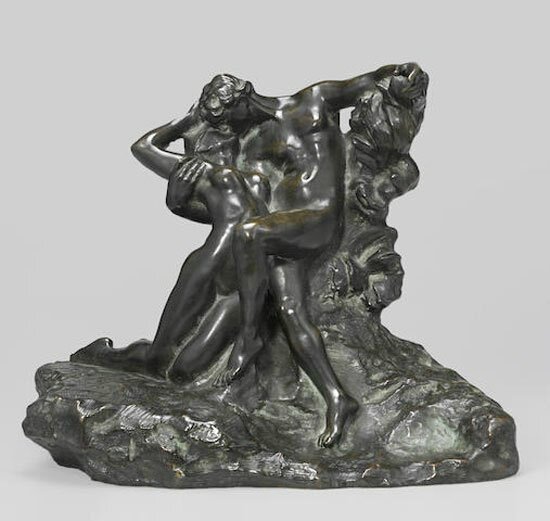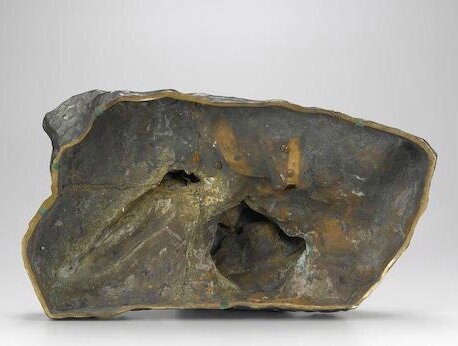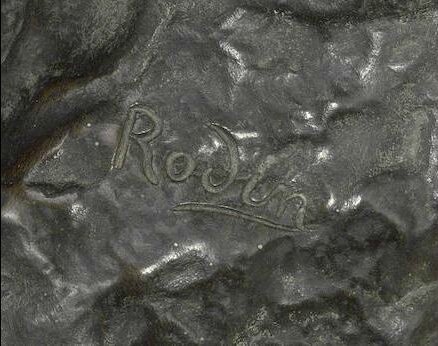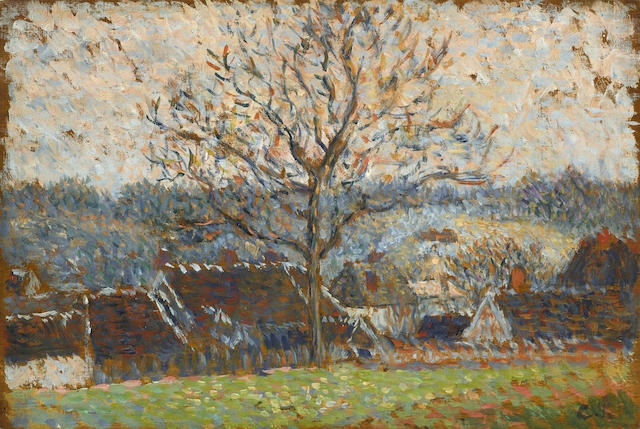Kokoschka world record set at Bonhams Impressionist & Modern Art Auction
NEW YORK.- Oskar Kokoschka’s Sitzender bärtiger Mann (1907) set a world auction record for a work on paper at U.S. $425,000 with premium at the Bonhams New York’s Impressionist and Modern Art sale on May 11.
Lot 21. Oskar Kokoschka (1886-1990), Sitzender bärtiger Mann, signed with initials 'OK' (lower right), graphite and watercolor on light brown paper, 16 7/8 x 12 1/8 in ( 42.7 x 30.8 cm). Drawn in 1907. Sold for US$ 425,000 (€374,515) inc. premium. world auction record for a work on paper. Photo: Bonhams.
(Cf. my post of 20 avril 2016)
It followed the exceptional sculpture Eve by Auguste Rodin, which led the sale achieving U.S. $1,061,000 with premium.
Lot 30. Auguste Rodin (1840-1917), Eve, petit modèle, version à la base carrée, dite aussi 'aux pieds plats', signed 'A. Rodin' (on the top of the base, back right) and inscribed with the foundry mark 'Alexis. Rudier./ Fondeur. Paris.' (on the back right of the left); and with the raised signature 'A. Rodin' on the interior, bronze with rich dark brown patina, 29 5/8 in (75.2 cm) (height). Conceived in 1883 and cast between 1925 and 1935. Sold for US$ 1,061,000 (€934,966) inc. premium. Photo: Bonhams.
(Cf. my post of 20 avril 2016)
In response to a remarkable collection of works the saleroom was abuzz with bidders on the floor, online and over the telephone from around the world, resulting in sell-through rates of 91% by value and 80% by lot.
Lot 36. Auguste Rodin (1840-1917), L'Éternel printemps, second état, troisième réduction, signed 'Rodin' (on the lower right of the base), with the foundry mark 'F. Barbedienne Fondeur' (on the back of the base) and with workshop stamp '16' to the interior, bronze with dark green patina, 15 3/4 in (40 cm) (height). Conceived in 1884, and in this reduced size in 1898. The present work cast between 1898 and 1918. Sold for US$ 245,000 (€215,897) inc. premium. Photo: Bonhams.
Anon. sale, Christie's, London, 25 June 1998, lot 164.
Acquired at the above sale by the present owner.
G. Grappe, Le Musée Rodin, Paris, 1944, no. 113 (another cast illustrated).
R. Descharnes and J.-F. Chabrun, Auguste Rodin, London, 1967, p. 134 (another cast illustrated).
I. Jianou and C. Goldscheider, Rodin, Paris, 1967, pl. 56-57 (another cast illustrated).
B. Champigneulle, Rodin, Paris, 1967, no. 34 (another version illustrated).
J.L. Tancock, The Sculpture of Auguste Rodin, Philadelphia, 1976, nos. 32a, 32b, 32-4 (other casts illustrated pp. 242, 243, 246).
A.E. Elsen, Rodin Rediscovered, Washington D.C., 1981, fig. 3.13 (another version illustrated).
A.E. Elsen, Rodin's Art, New York, 2003, no. 413 (other casts illustrated pp. 494-496).
D. Finn and M. Busco, Rodin and His Contemporaries: The Iris and B. Gerald Cantor Collection, New York, 1991 (another cast illustrated).
A. Le Normand-Romain, The Bronzes of Rodin, Catalogue of Works in the Musée Rodin, vol. I, Paris, 2007, p. 334 (other casts illustrated).
Lot 6. Jean Metzinger (1883-1956), Arbres près d'une rivière, signed 'J. Metzinger' (lower right), oil on canvas, 21 1/4 x 28 3/4 in (54 x 73 cm). Painted circa 1905. Estimate: U.S. $120,000 - 180,000 (€110,000 - 160,000). Sold for US$ 221,000 (€194,747) inc. premium. Photo: Bonhams.
(Cf. my post of 20 avril 2016)
Provenance: Marguerite Caetani, née Chapin, Principessa di Bassiano, Duchessa di Sermoneta (1880-1963).
Anon. sale, Christie's, London, 25 June 1984, lot 3.
Acquired at the above sale by the present owner.
Literature: J. Pissarro and C. Durand-Ruel Snollaerts, Pissarro, Catalogue critique des peintures, vol. III, Milan, 2005, p. 565, no. 862.
Note: Marguerite Caetani, former owner of this painting, was one of the most influential literary patrons of the early twentieth century. She was born in Connecticut in 1880 into the storied Chapin family, descended from Deacon Samuel Chapin who left England for the New World in 1635. Her extended relatives included T.S. Elliot, J.P. Morgan, William Howard Taft, Grover Cleveland, Harriet Beecher Stowe and the abolitionist John Brown, among others (H. Barolini, Their Other Side: Six American Women and the Lure of Italy, New York, 2006, p. 183). Orphaned at an early age she rebelled against the expectations of her class and left for Paris in 1903 to study singing. There she met and married the Italian aristocrat, composer and collector Roffredo Caetani, Prince of Bassiano, later the last Duke of Sermoneta. During the 1920s the 'Sunday Lunches' at the Caetanis' Villa Romaine in Versailles were frequented by the star literary, visual, and musical artists of the day, from James Joyce and Paul Valéry to Picasso, Collette, and Stravinsky (Barolini, op. cit., p. 194). In the fall of 1924, Marguerite turned her artistic and literary passion into a business venture, starting the revue Commerce, which published a number of unseen excerpts from Joyce's Ulysses, poems by T.S. Eliot (or simply "Cousin Tom"), and works by other English language authors including Faulkner and Woolf, all translated into French. While the review was extremely well received, and Marguerite was a darling of the Parisian artistic set, she never strove for celebrity and ultimately remained behind the scenes. Despite a gallant attempt at making ends meet, the economic hardship of the 1930s meant that Marguerite could not continue to provide the funds necessary to keep publishing Commerce. The Caetanis returned to Italy, moving into the Palazzo Caetani in the Via delle Botteghe Oscure in Rome. After the Second World War and the death of her only son on the Albanian front, Marguerite founded a second literary review, Botteghe Oscure. The review ran from 1948 until 1960 and was divided between Italian writings, and foreign works in their original language. It was originally published anonymously, but in the 1950s Marguerite added her name to the masthead. As with Commerce, she never stepped into the limelight, nor did she contribute any of her own writings. The remarkable list of contributors included W.H. Auden, Dylan Thomas, André Malraux, Truman Capote, and Carlos Fuentes. The review finally ceased publication in 1960, three years before the death of its founder
Provenance: Private Collection, Halle, Germany.
By descent from the above to the previous owner.
Literature: U. Berger, Georg Kolbe: Leben und Werk, mit dem Katalog der Kolbe-Plastiken im Georg-Kolbe-Museum, Berlin, 1990, no. 113 (the cast in the collection of the museum illustrated pp. 196 and 311).
Note: This work is recorded in the archives of the Georg Kolbe Museum. The figure was conceived by Kolbe, together with a pendant male figure Herabschreitender, in connection with his ambitious monument to Beethoven (1926-1947), which was only installed in Frankfurt after the sculptor's death. Two casts of this model, the present work and the version now in the Georg Kolbe Museum, Berlin, were cast in December 1927 or January 1928, while the third and final work from the edition, now lost (presumed destroyed), was cast in 1937-38.
We are grateful for the assistance of Dr. Ursel Berger in cataloging this work.
/https%3A%2F%2Fprofilepics.canalblog.com%2Fprofilepics%2F1%2F0%2F100183.jpg)
/https%3A%2F%2Fstorage.canalblog.com%2F03%2F02%2F119589%2F96711876_o.jpg)
/https%3A%2F%2Fstorage.canalblog.com%2F11%2F31%2F119589%2F94773502_o.jpg)
/https%3A%2F%2Fstorage.canalblog.com%2F20%2F83%2F119589%2F94772815_o.jpg)
/https%3A%2F%2Fstorage.canalblog.com%2F26%2F72%2F119589%2F75604929_o.jpg)
/https%3A%2F%2Fstorage.canalblog.com%2F59%2F60%2F119589%2F26458628_o.jpg)
















/http%3A%2F%2Fstorage.canalblog.com%2F04%2F34%2F119589%2F126029126_o.jpg)
/http%3A%2F%2Fstorage.canalblog.com%2F21%2F11%2F119589%2F111706210_o.jpg)
/http%3A%2F%2Fstorage.canalblog.com%2F05%2F84%2F577050%2F40293717_p.jpg)
/http%3A%2F%2Fstorage.canalblog.com%2F73%2F60%2F119589%2F35495001_o.jpg)